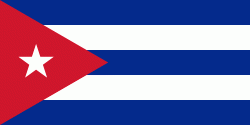Cuban convertible peso
$
The convertible peso (sometimes given as CUC$ and informally called a cuc or a chavito) was one of two official currencies in Cuba, the other being the Cuban peso. It had been in limited use since 1994, when its value was pegged 1:1 to the United States dollar.On 8 November 2004, the U.S. dollar ceased to be accepted in Cuban retail outlets and left the convertible peso as the only currency in circulation in many Cuban businesses. Officially exchangeable only within the country, its value was increased to US$1.08 in April 2005, but reverted to US$1.00 on 15 March 2011. The convertible peso was, by the pegged rate, the twelfth-highest-valued currency unit in the world and the highest-valued "peso" unit.
On 22 October 2013, it was announced that the currency was to be scrapped. On 10 December 2020, it was announced that monetary unification would take effect from 1 January 2021. From that date, the CUC was no longer accepted in many Cuban businesses; it could only be exchanged in banks or CADECAs (casas de cambios), or used in certain shops, for a six-month period. On 15 June 2021, it was announced that the CUC would remain exchangeable in banks for a further six months but that no shops would accept them from 1 July. The final date for exchanging CUCs was 30 December 2021.
In 1981–1989, Cuba used so-called INTUR coins and cheques. Convertible foreign currency was exchanged into these cheques rather than the national currency, which could be used to buy some luxury goods not available for purchase in the national currency.
Also, from 1985, Banco Nacional de Cuba issued foreign exchange certificates of various types.
Because of the economic problems during the Special Period, the Cuban government allowed the possession of U.S. dollars (which had previously been illegal) and began selling goods and services in U.S. dollars, initially for tourism and for luxury items.. In 1994, they began issuing the convertible peso, to circulate together with the U.S. dollar.
This was separate from the Cuban peso (CUP), which was used for staple items. The Cuban peso (CUP) can be exchanged to the convertible peso (CUC) at exchange offices (CADECA) at a fixed rate. Since the early 2000s the rates have been 24 CUP to 1 CUC (sell) and 25 CUP to 1 CUC (buy); but for state bookkeeping purposes, both pesos are valued at a 1:1 rate.
On 8 November 2004, the Cuban government withdrew the U.S. dollar from circulation, citing the need to retaliate against further sanctions from the Helms–Burton Act. After a grace period ending on 14 November 2004, a 10% surcharge began to be imposed when converting U.S. dollars into convertible pesos. The change was announced some weeks beforehand, and was extended by the grace period. It has been claimed that it was because the amounts of U.S. dollars being exchanged were more than anticipated. The measure helped the Cuban government collect hard currency. From 2014, some state-owned shops began to set the prices in both CUC and CUP, and accept payment in either. The 10% surcharge on converting US dollars was removed in July 2020.
Cuba's economic difficulties since the end of 2019 have resulted in shortages of goods in CUP and CUC stores, the opening of stores priced in US dollars and only accepting payment by cards backed by foreign currencies, the waiving of the 10% penalty for exchanging US dollars, the resumption of US dollars as unofficial medium of exchange, and the plunge in the value of the CUC below US$1 in unofficial street exchanges.
Country
-
Cuba
Cuba, officially the Republic of Cuba (República de Cuba ), is an island country comprising the island of Cuba, as well as Isla de la Juventud and several minor archipelagos. Cuba is located where the northern Caribbean Sea, Gulf of Mexico, and Atlantic Ocean meet. Cuba is located east of the Yucatán Peninsula (Mexico), south of both the American state of Florida and the Bahamas, west of Hispaniola (Haiti/Dominican Republic), and north of both Jamaica and the Cayman Islands. Havana is the largest city and capital; other major cities include Santiago de Cuba and Camagüey. The official area of the Republic of Cuba is 109,884 km2 (without the territorial waters) but a total of 350,730 km2 including the exclusive economic zone. Cuba is the second-most populous country in the Caribbean after Haiti, with over 11 million inhabitants.
The territory that is now Cuba was inhabited by the Ciboney people from the 4th millennium BC with the Guanahatabey and Taíno peoples until Spanish colonization in the 15th century. From the 15th century, it was a colony of Spain, and slavery was abolished in 1886, remaining a Spanish colony until the Spanish–American War of 1898, when Cuba was occupied by the United States and gained independence in 1902. In 1940, Cuba implemented a new constitution, but mounting political unrest culminated in a coup in 1952 and the subsequent dictatorship of Fulgencio Batista, which was later overthrown in January 1959 by the 26th of July Movement during the Cuban Revolution, which afterwards established communist rule under the leadership of Fidel Castro. The country was a point of contention during the Cold War between the Soviet Union and the United States, and a nuclear war nearly broke out during the Cuban Missile Crisis of 1962. Following the collapse of the Soviet Union, Cuba faced a severe economic downturn in the 1990s, known as the Special Period. In 2008, Fidel Castro resigned after 49 years of leadership of Cuba and was replaced by his brother Raúl Castro.
